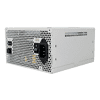 8
8
Super Flower Leadex III ARGB Gold 650 W Review
Performance Rating: Stability, Noise & Efficiency »Protection Features Evaluation
| Protection Features | |
|---|---|
| OCP | 12 V: 59 A (109.06%), 12.128 V 5 V: 28 A (140%), 4.983 V 3.3 V: 28 A (140%), 3.284 V 5 VSB: 5 A (166.67%), 4.922 V |
| OPP | 721.5 W (111%) |
| OTP | Yes (130 °C @ 12 V Heatsink) |
| SCP | +12 V: Yes +5 V: Yes +3.3 V: Yes 5VSB: Yes -12 V: Yes |
| PWR_OK | Proper Operation |
| NLO | Yes |
| SIP | Surge: MOV Inrush: NTC & Bypass Relay |
OCP at +12 V and the OPP triggering points are set correctly. However, OCP is set quite high on the minor rails, which doesn't seem to create load regulation or ripple suppression issues. Finally, there is over temperature protection (OTP), which works well, and the power ok signal is accurate.
DC Power Sequencing
According to Intel's most recent Power Supply Design Guide (revision 1.4), the +12 V and +5 V rails must have voltages equal to or greater than the +3.3 V rail's output at all times. For our first measurement, we turn the unit off and switch it back on without a load on any of the rails.The 3.3 V rail is always at a lower voltage than the other two rails.
EMC Pre-Compliance Testing - Average and Quasi-Peak EMI Detector Results
Electromagnetic Compatibility (EMC) is the ability of a device to operate properly in its environment without disrupting the proper operation of other close-by devices.Electromagnetic Interference (EMI) stands for the electromagnetic energy a device emits, and it can cause problems in other close-by devices if too high.

EMI emissions are low.
Jul 18th, 2025 19:20 CDT
change timezone
Latest GPU Drivers
New Forum Posts
- Anime Nation (13052)
- What's your latest tech purchase? (24305)
- AI Job Losses: let's count the losses up, total losses to AI so far 94,000 and counting (35)
- lower score 5070Ti after replacing the PSU (0)
- TPU's Nostalgic Hardware Club (20539)
- 3DMARK "LEGENDARY" (329)
- Hatsune Miku x ASUS TUF Gaming Build (67)
- Ferrari themed mod cont. 4070s repaste (7)
- Stalker 2 is looking great. (213)
- Share your CPU-X Benchmarks! (6)
Popular Reviews
- MSI GeForce RTX 5060 Gaming OC Review
- Razer Blade 16 (2025) Review - Thin, Light, Punchy, and Efficient
- Thermal Grizzly WireView Pro Review
- Pulsar X2 Crazylight Review
- SilverStone SETA H2 Review
- AVerMedia Live Gamer Ultra S (GC553Pro) Review
- Upcoming Hardware Launches 2025 (Updated May 2025)
- Sapphire Radeon RX 9060 XT Pulse OC 16 GB Review - An Excellent Choice
- NVIDIA GeForce RTX 5050 8 GB Review
- Our Visit to the Hunter Super Computer
TPU on YouTube
Controversial News Posts
- Intel's Core Ultra 7 265K and 265KF CPUs Dip Below $250 (288)
- Some Intel Nova Lake CPUs Rumored to Challenge AMD's 3D V-Cache in Desktop Gaming (140)
- AMD Radeon RX 9070 XT Gains 9% Performance at 1440p with Latest Driver, Beats RTX 5070 Ti (131)
- NVIDIA Launches GeForce RTX 5050 for Desktops and Laptops, Starts at $249 (124)
- NVIDIA GeForce RTX 5080 SUPER Could Feature 24 GB Memory, Increased Power Limits (115)
- Microsoft Partners with AMD for Next-gen Xbox Hardware (105)
- NVIDIA DLSS Transformer Cuts VRAM Usage by 20% (99)
- AMD Sampling Next-Gen Ryzen Desktop "Medusa Ridge," Sees Incremental IPC Upgrade, New cIOD (97)


